Use of Gas Chromatography-Mass Spectrometry Techniques (GC-MS, GC-MS/MS and GC-QTOF) for the Characterization of Photooxidation and Autoxidation Products of Lipids of Autotrophic Organisms in Environmental Samples
- PMID: 35268730
- PMCID: PMC8911584
- DOI: 10.3390/molecules27051629
Use of Gas Chromatography-Mass Spectrometry Techniques (GC-MS, GC-MS/MS and GC-QTOF) for the Characterization of Photooxidation and Autoxidation Products of Lipids of Autotrophic Organisms in Environmental Samples
Abstract
This paper reviews applications of gas chromatography-mass spectrometry techniques for the characterization of photooxidation and autoxidation products of lipids of senescent phototrophic organisms. Particular attention is given to: (i) the selection of oxidation products that are sufficiently stable under environmental conditions and specific to each lipid class and degradation route; (ii) the description of electron ionization mass fragmentation of trimethylsilyl derivatives of these compounds; and (iii) the use of specific fragment ions for monitoring the oxidation of the main unsaturated lipid components of phototrophs. The techniques best geared for this task were gas chromatography-quadrupole-time of flight to monitor fragment ions with very high resolution and accuracy, and gas chromatography-tandem mass spectrometry to monitor very selective transitions in multiple reaction monitoring mode. The extent of the degradation processes can only be estimated if the oxidation products are unaffected by fast secondary oxidation reactions, as it is notably the case of ∆5-sterols, monounsaturated fatty acids, chlorophyll phytyl side-chain, and di- and triterpenoids. In contrast, the primary degradation products of highly branched isoprenoid alkenes possessing more than one trisubstituted double bond, alkenones, carotenoids and polyunsaturated fatty acids, appear to be too unstable with respect to secondary oxidation or other reactions to serve for quantification in environmental samples.
Keywords: EI fragmentation; TMS derivatives; autoxidation; environment; gas chromatography-mass spectrometry; photooxidation; senescent phototrophs; specific tracers; unsaturated lipids.
Conflict of interest statement
The author declares no conflict of interest.
Figures












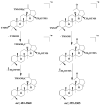


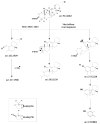
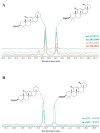



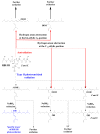
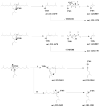
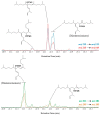

Similar articles
-
Electron ionization mass spectrometric fragmentation and detection of autoxidation products of 2,6,10,14-tetramethyl-7-(3-methylpent-4-enyl)-pentadec-5-ene in Arctic sediments.Rapid Commun Mass Spectrom. 2020 Aug 15;34(15):e8816. doi: 10.1002/rcm.8816. Rapid Commun Mass Spectrom. 2020. PMID: 32315098
-
Free radical oxidation (autoxidation) of alkenones and other lipids in cells of Emiliania huxleyi.Phytochemistry. 2007 Mar;68(6):913-24. doi: 10.1016/j.phytochem.2006.12.013. Epub 2007 Jan 26. Phytochemistry. 2007. PMID: 17258251
-
Electron ionization mass spectrometry fragmentation pathways of trimethylsilyl derivatives of isomeric allylic alcohols derived from HBI alkene oxidation.Rapid Commun Mass Spectrom. 2014 Sep 15;28(17):1937-47. doi: 10.1002/rcm.6974. Rapid Commun Mass Spectrom. 2014. PMID: 25088137
-
Characterization of isomeric allylic diols resulting from chlorophyll phytyl side-chain photo- and autoxidation by electron ionization gas chromatography/mass spectrometry.Rapid Commun Mass Spectrom. 2005;19(5):637-46. doi: 10.1002/rcm.1835. Rapid Commun Mass Spectrom. 2005. PMID: 15685684
-
Non-enzymatic lipid oxidation products in biological systems: assessment of the metabolites from polyunsaturated fatty acids.J Chromatogr B Analyt Technol Biomed Life Sci. 2014 Aug 1;964:65-78. doi: 10.1016/j.jchromb.2014.04.042. Epub 2014 Apr 29. J Chromatogr B Analyt Technol Biomed Life Sci. 2014. PMID: 24856297 Review.
Cited by
-
Cellular Damage of Bacteria Attached to Senescent Phytoplankton Cells as a Result of the Transfer of Photochemically Produced Singlet Oxygen: A Review.Microorganisms. 2023 Jun 13;11(6):1565. doi: 10.3390/microorganisms11061565. Microorganisms. 2023. PMID: 37375067 Free PMC article. Review.
-
Retrospective Analysis of Gut Microbiota and Metabolomic Profiles in Pregnant Women: Association with Cesarean Section Risk.Int J Womens Health. 2025 Jun 12;17:1763-1770. doi: 10.2147/IJWH.S526040. eCollection 2025. Int J Womens Health. 2025. PMID: 40530360 Free PMC article.
-
Recent advances in nanomaterials-based electrochemical sensors for tramadol analysis.ADMET DMPK. 2023 Apr 16;11(2):117-134. doi: 10.5599/admet.1593. eCollection 2023. ADMET DMPK. 2023. PMID: 37325110 Free PMC article. Review.
-
Functional metabolomics: unlocking the role of small molecular metabolites.Front Mol Biosci. 2025 Jul 9;12:1542100. doi: 10.3389/fmolb.2025.1542100. eCollection 2025. Front Mol Biosci. 2025. PMID: 40703706 Free PMC article. Review.
-
The Chemical Reactivity of Membrane Lipids.Chem Rev. 2024 Mar 27;124(6):3284-3330. doi: 10.1021/acs.chemrev.3c00608. Epub 2024 Mar 18. Chem Rev. 2024. PMID: 38498932 Free PMC article. Review.
References
-
- Harwood J.L., Russell N.J. Lipids in Plants and Microbes. Springer; Dordrecht, The Netherlands: 1984. pp. 7–32.
-
- Ben-Amotz A., Tornabene T.G., Thomas W.H. Chemical profile of selected species of microalgae with emphasis on lipids. J. Phycol. 1985;21:72–81. doi: 10.1111/j.0022-3646.1985.00072.x. - DOI
-
- Volkman J.K. Lipid markers for marine organic matter. Handb. Environ. Chem. 2006;2:27–70.
Publication types
MeSH terms
Substances
Grants and funding
LinkOut - more resources
Full Text Sources
Miscellaneous

